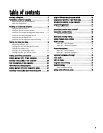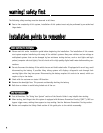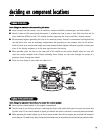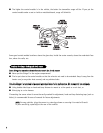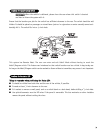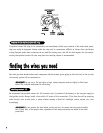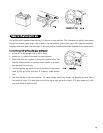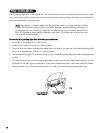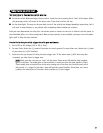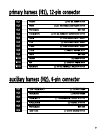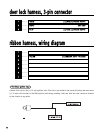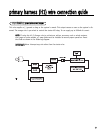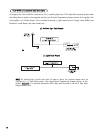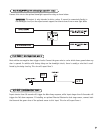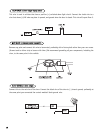
1111
TThhee bbeesstt ppllaacceess ttoo ffiinndd tthhee ddoooorr sswwiittcchh wwiirree aarree::
■ At the pin switch: When testing at the pin switch, check the wire to ensure that it “sees” all the doors. Often,
the passenger switch will cover all the doors even if the driver’s switch will not.
■ At the dome light: This may not be your best choice if the vehicle has delayed domelight supervision, but it
will work in many Hondas, or any vehicle with completely diode-isolated pin switches.
Once you have determined the wire color, the easiest place to connect to the wire is often at the kick panel, at
the windshield pillar, or in the running board. When an easy location is not available, running a wire to the dome-
light itself is often the best solution.
HHooww ttoo ffiinndd aa ddoooorr ppiinn sswwiittcchh ttrriiggggeerr wwiirree
wwiitthh yyoouurr mmuullttiimmeetteerr::
1. Set to DCV or DC voltage (12V or 20V is fine).
2. In most Fords, fasten the (-) probe of the meter to chassis ground. In most other cars, fasten the (+) probe
of your meter to (+)12V constant.
3. Probe the wire you suspect of being the door trigger wire. If the meter reads (+)12V when any door
is opened, you have found a trigger wire.
NNOOTTEE::
Make sure the wire you use “sees” all the doors! Some newer GM vehicles lack standard-
type pin switches. The dome light in these vehicles is turned on when the door handle is lifted.
These usually have a blue/white or white wire coming out of the door into the kick panel which
will provide a (-) trigger for all doors. Some GM vehicles (some Cavaliers, Grand Ams, etc.) have
a yellow wire coming out of the door which provides a (+) door trigger.
ffiinnddiinngg tthhee ddoooorr ppiinn sswwiittcchh cciirrccuuiitt



